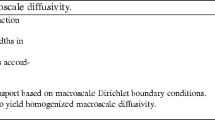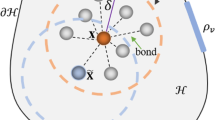The hygrothermal process can change the porosity and the permeability of concrete, causing the initiation and the growth of the cracks, and thus deteriorating the integrity of the concrete structure. A numerical formulation based on the finite element method is developed to carry out the simulation of the initiation and the propagation of the cracks caused by the coupled field of thermal transfer and moisture transport. An original concept based on three-dimensional stress state of the integration points in each finite element is described. The global relative crack density is used to denote the cracking state of the entire concrete structure, which may serve as an appropriate index to evaluate the overall deterioration level of the structure.







Similar content being viewed by others
References
L. Basheer, J. Kropp, and D. J. Cleland, “Assessment of the durability of concrete from its permeation properties: a review,” Constr. Build. Mater., 15, No. 2, 93–103 (2001).
T. Ishida and K. Maekawa, “Modeling of pH profile in pore water based on mass transport and chemical equilibrium theory,” in: Proc. of JSCE, No. 648/V-47 (2000), pp. 125–140.
O. B. Isgor and A. G. Razaqpur, “Finite element modeling of coupled heat transfer, moisture transport and carbonation processes in concrete structure,” J. Cement Concrete Compos., 26, No. 1, 57–73 (2004).
ANSYS Theory Reference: Analysis Tools, 001099, 9th edition, SAS IP, Inc.
ANSYS 8.0. The General Purpose of Finite Element Software. Documentation.
C. M. Aldea, S. P. Shah, and A. Karr, “Permeability of cracked concrete,” Mater. Struct., 32, No. 219, 370–376 (1999).
D. Ngo and A. C. and Scordelis, “Finite element analysis of reinforced- concrete beams,” J. Amer. Concrete Inst., 65, No. 9, 757–766 (1967).
J. Alfaiate, E. B. Pires, and J. A. C. Martins, “A finite element analysis of non-prescribed crack propagation in concrete,” Comput. Struct., 63, No. 1, 17–26 (1997).
R. de Borst, “Some recent developments in computational modeling of concrete fracture,” Int. J. Fracture, 86, No. 1-2, 5–36 (1997).
Y. C. Loo and H. Guan, “Cracking and punching shear failure analysis of RC flat plates,” ASCE J. Struct. Eng., 123, No. 10, 1321–1330 (1997).
K. J. William and E. P. Warnke, “Constitutive model for the triaxial behavior of concrete,” in: Proc. of the International Association for Bridge and Structural Engineering, ISMES, Bergamo, Italy (1975), Vol. 19, p. 174.
A. V. Saetta, B. A. Schrefler, and R. V. Vitaliani, “2D model for carbonation and moisture/heat flow in porous materials,” Cement Concrete Res., 25, No. 8, 1703–1712 (1995).
Author information
Authors and Affiliations
Corresponding author
Additional information
Translated from Problemy Prochnosti, No. 6, pp. 94 – 103, November – December, 2011.
Rights and permissions
About this article
Cite this article
Dahmani, L. Mechanical stresses and crack analysis of concrete under the hygrothermic effect. Strength Mater 43, 654–661 (2011). https://doi.org/10.1007/s11223-011-9338-1
Received:
Published:
Issue Date:
DOI: https://doi.org/10.1007/s11223-011-9338-1




